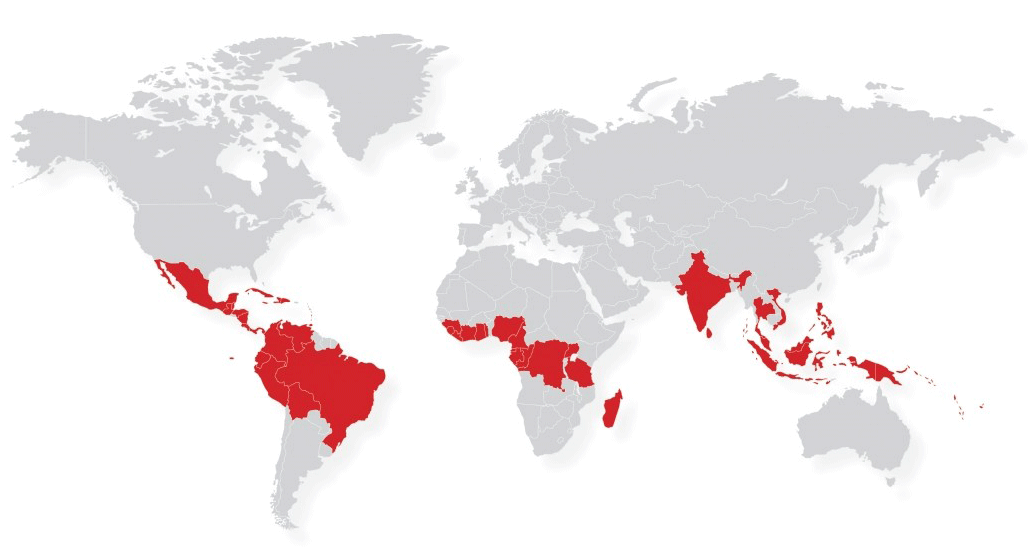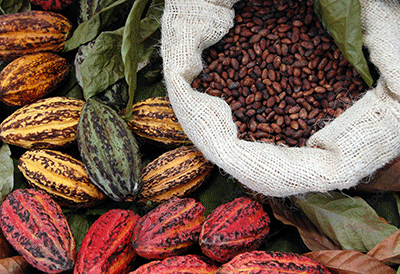BEIYAN COCOA BEAN SOURCING
The cocoa bean or simply cocoa is the dried and fully fermented seed of Theobroma cacao, from which cocoa solids and cocoa butter can be extracted. The cacao plant was first given its botanical name by Swedish natural scientist Carl Linnaeus in his original classification of the plant kingdom, where he called it Theobroma ("food of the gods") cacao.
Cacao trees grow in a limited geographical zone, of about 20° to the north and south of the Equator. Nearly 70% of the world crop today is grown in West Africa.

The high-quality cocoa beans are about 22 mm long, about 8 mm thick, and have full grains, with an average weight of about 104 g per 100 grains. Different types and varieties of cocoa beans have different particle sizes. Generally, cocoa beans contain a certain amount of moldy beans, broken beans, insect-eaten beans, sprouted beans and deflated beans, and blue-gray stiff beans that are not fully fermented.
The classification of cocoa bean grades is to divide cocoa beans into four grades according to the proportion of defective beans and blue-gray beans: first class cocoa beans: not more than 5% defective and blue-gray beans; secondary cocoa beans: not more than 10% defective and blue-gray beans; grade 3 cocoa beans: no more than 10% for defective beans and no more than 20% for blue-grey beans; grade 4 cocoa beans: no more than 10% defective beans, no regulations for blue-gray beans.
Beiyan.com only provide first grade cocoa beans whatever origin. Most of the cacao we source comes from smallholder farmers, committed to preserving indigenous cacao varieties and experimenting with different processes to explore flavour diversity working in harmony with nature and respect for people and the environment.
BEST COCOA BEAN SOURCED FOR BEAN TO BAR ARTISAN
Which origin?
We provide many origins that can fit your needs. Our MOQ is usually 500 kg by origin.
For rare origins we can have order per bag of 20 to 70 kg depending of grower.
You can mix your order but price are higher.
Shipping costs will be calculated separately depending your destination.
You can also book a quantity on next harvests.
Each cacao bean we select undergoes different and rigorous quality checks.

Traditional types of cocoa trees
In the traditional classification there are three main categories of cocoa trees among the world crops: Criollo, Trinitario and Forastero.
Each of these trees yields beans whose uses vary, depending on its characteristics and the conditions in which it is grown.
Cocoa tree Criollo
Very slightly bitter, cocoa from the Criollo group offers a strong aroma and remarkable taste finesse.
Cocoa tree Forastero
Its production represents 80% to 90% of world cocoa production. This group of trees is recognizable by its smooth yellow and green pods, by its purple-colored almonds and by the bitter flavor of its cocoa. The cocoa beans from these cocoa trees contain tannin in large quantities. This type of tree has 30 to 40 cocoa beans per pod.
Cocoa tree Trinitario
It is very likely that they are hybrids resulting from a cross between a variety of Criollo and Amazonian Forastero. Its production represents 10% to 15% of world cocoa production.
Like the Criollo, the Trinitario have red pods, then orange when ripening. On average, 150 pods are produced by a shrub in a year, which is equivalent to about 6 kg of cocoa.
New classification
- The Amelonado cocoa tree: quite fat, a little bitter and releases aromas of coffee, wood and spices (mainly cinnamon and vanilla).
- The Criollo cocoa tree: not very bitter, it offers a delicate flavor.
- The National cocoa tree: naturally sweet and slightly bitter, not very fatty, it produces a unique bouquet of aromas that blend floral violet, lilac, jasmine and orange blossom. Depending on its origin, it can give off scents of black figs and cinnamon.
- The Contamana cocoa tree: its flavor evokes a complex of dried brown fruits and flowers.
- The Curaray cocoa tree: has not yet been enough studied to give precise characteristics.
- The Guiana cocoa tree: Guiana generates a taste of great finesse, enhanced by a slight bitterness. High aromatic intensity.
- The Iquitos & Nanay cocoa trees: they are quite bitter, generate tannins giving body and breadth to the resulting chocolate requiring longer fermentation and higher roasting temperature to reduce the inherent bitterness, acidity and astringency.
- The Marañon cocoa tree: from wild cocoa trees it have a fruity and floral taste.
- The Purus cocoa: renowned for its intense color and its flavors are quite spicy and above all very rich giving high quality chocolates, but often expensive, because it requires a lot of labor to harvest.
